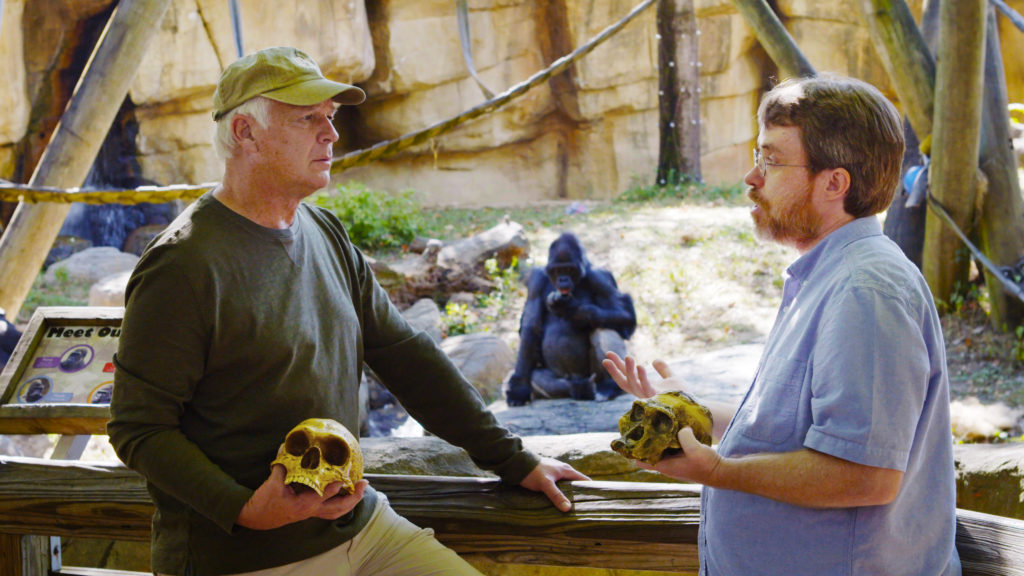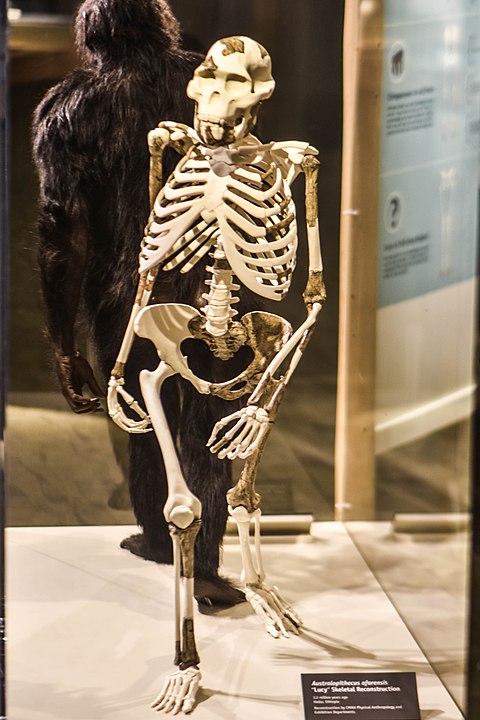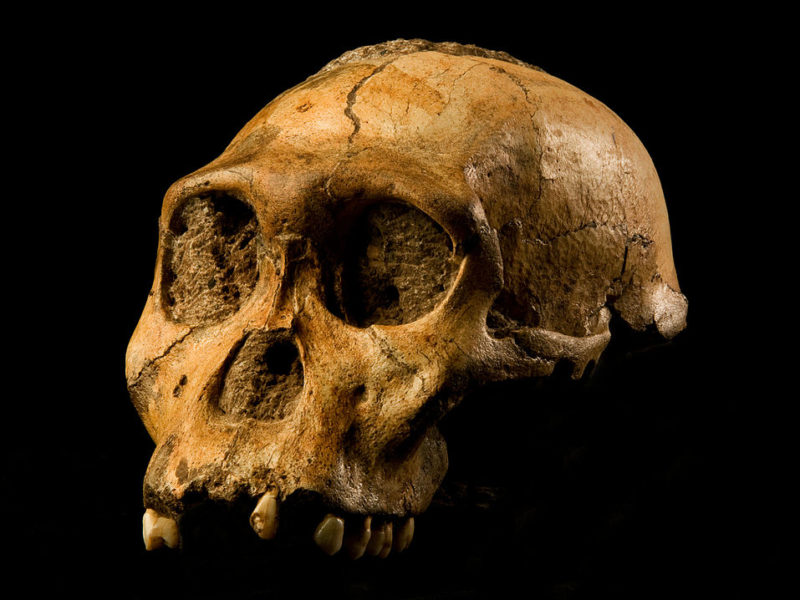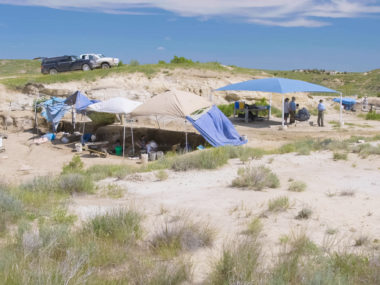In the first few months of 2010, I was working on a research paper describing the baraminology of humans. Baraminology is the field of creation research that tries to identify created kinds. I had been working on mathematical ways of examining species for more than a decade at that point, and I applied the techniques to creatures as diverse as insects, horses, and sunflowers. The fall of 2009 was my first foray into humans, and the results turned out pretty well. Nothing surprising or dangerous: humans were humans and apes were apes. That’s good news! So I finished up my paper and sent it to Answers Research Journal for peer review and publication. The reviews were mostly positive with a few suggested changes, so I got to work on making what I thought would be minor tweaks to the manuscript.
The following article is an excerpt from The Quest: Exploring Creation’s Hardest Problems, Ch. 2, pgs. 21-31. The views expressed reflect those of the author, and not necessarily those of New Creation.
Then Australopithecus sediba was announced to the world the week of April 9, 2010.1 Lee Berger, a Georgia-born paleontologist living in South Africa, had been investigating possible fossil locations in a large region called the “Cradle of Humankind,” when his son stumbled across the first signs of the sediba skeleton, a collarbone sticking out of a rock. The discovery made the cover of the journal Science, and it was all over the news. Lee Berger’s research team was pretty blunt about what they thought it meant, too: Australopithecus sediba was the most similar ape-like creature to human beings. In evolutionary language, sediba was a “stem taxon” or a “transitional form.” This was yet another link connecting human beings to their supposed animal ancestors.

Other creationists were quick to claim that sediba was just another ape masquerading as a human ancestor.2 I was intrigued and excited by the whole thing and inserted sediba into my own baraminology analysis of humans. I have to admit that I freaked out a bit when I got the results. My new analysis still showed a good separation between humans and apes, but sediba wasn’t on the ape side. My results showed that sediba was human.
Naturally, I did what any scientist would do when they get dubious results: I did it again. I tried a different set of species. I tried a different set of characteristics. I tried everything I could justify scientifically. Every time, I got the same answer: sediba groups with the humans. So I had to accept it. Based on the data that I had and the techniques I used, Astralopithecus sediba was human.
Because so many other creationists had so quickly judged sediba as non-human, I knew this research was going to get me in trouble. So I decided to fully own it. I changed the title of my paper from a harmless little description of my research to something like “Australopithecus sediba is human!”3 I thought I might as well let everyone know what they were about to read.
Naturally, the responses were loud and mostly negative. To be honest, they had good reason to suspect that Australopithecus sediba was not human. The skeleton of sediba was far more ape-like than any other fossil that creationists judged to be human, but my analysis only examined the skull rather than the full skeleton. Up to that point, most creationists relied on skeletons more than skulls to tell what was human and what wasn’t. The skeletons were pretty clear, too. There was a mostly human type of skeleton, where the arms and legs and backbones look very much like modern humans. There was also an australopith skeleton, where the arms and rib cages were more like chimpanzee arms but the legs were sort of like ours. For creationists, it was easy to see the human type as actual humans and the australopith type as nonhuman animals. Australopithecus sediba looked like a human in the head but an australopith below the neck.
Here Come the Missing Links

By Profberger – Own work, CC BY-SA 3.0, https://commons.wikimedia.org/w/index.php?curid=28393918
That strange mix of ape and human characteristics was something that modern creationists had never anticipated. From the very beginning of the evolution war, when Darwin’s Origin of Species was first published, his critics asserted that the links connecting humans to apes were entirely absent, along with many other links between all the major types of creatures. This constant drumbeat became a sort of creationist doctrine: The so-called “missing link” was, is, and always will be missing. There are no transitional forms between humans and animals.
And yet, here is Australopithecus sediba, a creature with exactly the mix of characteristics that we might expect from a “missing link.” But remember: There are no missing links! Since sediba didn’t have a human-like skeleton, it must be an ape. It could not possibly be something in between. My disagreement was bound to make creationists uncomfortable (and even angry). I basically broke rank, which gives the evolutionists opportunity to laugh at us. After all, if it was so easy to tell the difference between humans and apes, then why don’t all creationists agree about sediba? That’s one reason my judgment about sediba is such a sore spot for other creationists. It’s not only about whether sediba is human. It’s much more fundamental. Creationist disagreement over sediba hints that the entire premise of “no missing links” might actually be wrong.4
Let’s think about that for a moment, and let’s try to put aside all our biases as creationists (yes, I know that’s impossible, but let’s try). Before we can say that there are no missing links, shouldn’t we have an idea of what a missing link might look like? If by “missing link,” we mean that creature that was the actual ancestor of all humans and whose parents were apes, then how would we know it if we saw it? It’s not like a genealogy study where we can trace family records and find grave markers. All we get from fossils are bone shapes and sizes and occasionally some DNA. We can tally up differences and similarities but that’s really it.

Maybe what we need to do then is look at lists of characteristics that distinguish humans and apes (here I’ll use the chimpanzee as my generic “ape”), and maybe then we can think about what an intermediate form might look like (instead of insisting that this or that fossil is or is not an ancestor).
So what do we find in the fossil record? Are there creatures that we might plausibly say either have a mixture of these characteristics or something in between? Here are a set of fossil forms and how they scored on our chart:

Now we could argue about whether these set of characteristics should tell us anything about evolutionary ancestors. We could even say (as I have done elsewhere) that in spite of all these characteristics, we can still use mathematics to identify what is human and what is not.5 But for now, I want to ponder this chart for a moment here, because this isn’t something creationists expected.
Take Lucy (Australopithecus afarensis) for example. Lucy is a partial skeleton discovered in Ethiopia in 1974. Lucy has three features in common with modern human beings, the big toe, thigh bone, and foramen magnum, all three of which are consistent with walking around on two legs. Lucy walked upright, sort of like we do. On the other hand, Lucy has four other features in common with the modern chimpanzee, mostly in her head. She has a pronounced muzzle, a small brain, and a heavy browridge. The proportions of her arms are suitable for climbing trees. Is Lucy the “missing link,” an ape ancestor of all modern human beings? I don’t know. No one could possibly know that, and there’s not really any way to test for it either. But Lucy does have characteristics of both modern humans and modern apes in one body. Lucy is an intermediate.
If you read early creationist literature, they make it pretty clear that nothing will ever be found that bridges the gap between human and non-human. I think that’s true, but I also think we need to make sure we’re clear about what it means. I think there is no half-human, half-animal creature that was part of our evolution from apes. But it’s hard to look at Lucy and the rest of that list above and say that there were never creatures that had characteristics of both living humans and living apes. In other words, there are creatures that might look kind of like intermediates, and if I were inclined to accept evolution, then I could see why people would think that these are our ancestors.
I know that’s hard to read. It’s hard to write. It’s traitorous, really, like confessing a murder. I’m basically conceding that evolutionary theory successfully predicted the existence of intermediate forms. There really are things that look sort of like “missing links.” It’s not just humans either. There are dinosaurs with feathers that sort of look like they could be the ancestors of birds. There are reptiles that have jaws like mammals that sort of look like they could be the ancestors of mammals. There are fossil whales with hind legs that sort of look like they could be the ancestors of modern whales. There are even fish with bony fins that sort of look like they could be the ancestors of all the bony land animals. The list goes on and on and on.
Take a Deep Breath
So what do we do about these intermediate fossils? First of all, don’t panic. Too many people get to this point and flip out. They feel like they’ve been lied to and that evolution is true after all! Or maybe they feel like I’m the liar and maybe I’ve been duped into believing in evolution! Maybe Jesus is all a lie! Or maybe I’m a wolf in sheep’s clothing! Danger! DANGER!
Stop. Just stop. Don’t panic. Take a deep breath, and think for a moment. What would José de Acosta do?
Acosta grew up knowing all about the global flood and how Noah saved all the kinds of animals in the ark. He had a really tough time explaining how all those people and unique creatures in South America could have gotten there from Noah’s ark. He didn’t know about the geography of Alaska and the genetic relationships between different people groups. He knew for sure that there were people in South America and that the voyage across the Atlantic Ocean was long and difficult. When it came to whether someone could cross the equator or live in the southern hemisphere, Acosta was willing to examine and even correct old beliefs, but he did it carefully and deliberately. He spent years thinking about these questions, and there were some questions he never could solve.
So what would Acosta do with intermediate forms, these supposed “missing links?” I think one thing he might do is look back to the scripture to make sure he got his beliefs right. After all, it’s at least possible that we made a mistake in our understanding of scripture. We can’t claim that we’re infallible, right? Let’s start there.
The creation of animals and people is recorded in the first chapters of Genesis. Especially in chapter one, we see God deliberately creating animals starting on the fifth day of creation week. Flying things and swimming things appear on day five, and a day later all the land animals show up. Each group of animals is created “according to its kind.” At the end of the author’s description of the sixth day, God creates human beings, not according to their kind but in his own image. The story is pretty straightforward, and it’s easy to understand. And there’s not a hint of evolution from previously-existing animal ancestors.
If Genesis 1 were the only passage in the Bible that talked about human creation, I could imagine that more Christians might reasonably disagree over its interpretation. Even though its meaning seems pretty obvious, I could still imagine someone arguing that all of Genesis 1 was just a metaphor, allegory, or parable. But Genesis 1 is just the beginning (literally and figuratively).
The subsequent chapters describe the origin of humanity in much greater detail, including the Lord’s careful crafting of Adam’s body from the dust of the ground. Adam and Eve then broke God’s one prohibitive command to abstain from the tree of the knowledge of good and evil, resulting in God’s curse on creation. In the New Testament, the apostle Paul would explain that this original sin of Adam was the reason that Jesus Christ had to come to earth and die. Paul wrote to the Romans,
Therefore, just as sin came into the world through one man, and death through sin, and so death spread to all men because all sinned… But the free gift is not like the trespass. For if many died through one man’s trespass, much more have the grace of God and the free gift by the grace of that one man Jesus Christ abounded for many. … For if, because of one man’s trespass, death reigned through that one man, much more will those who receive the abundance of grace and the free gift of righteousness reign in life through the one man Jesus Christ. Therefore, as one trespass led to condemnation for all men, so one act of righteousness leads to justification and life for all men. For as by the one man’s disobedience the many were made sinners, so by the one man’s obedience the many will be made righteous. (Romans 5:12, 15, 17-19).
Paul made a similar point in his first letter to the Corinthians:
For as by a man came death, by a man has come also the resurrection of the dead. For as in Adam all die, so also in Christ shall all be made alive.
I Corinthians 15:21-22
In the beginning, when the sum of humanity existed only as Adam and Eve, their sin, which God promised would bring death, did indeed bring death and suffering and guilt upon all people, who continued their forefather’s sinful ways. Jesus Christ’s resurrection from the dead defeated the death that Adam brought. Christ literally and bodily rose from the grave, just like Adam literally and bodily went to the grave because of his sin.
Paul is crystal clear on this point, and the church fathers unanimously agreed. When we examine the earliest generations of Christians who left written records after the New Testament, we find a complete affirmation of Paul’s teaching. Jesus Christ died and rose again to undo the curse brought upon humanity by the fall of Adam and Eve. This notion of Adam’s original sin has been a basic part of Christian identity from the beginning of Christianity.
And now we have evolution, which tells us that there was no special origin of humanity. There was no time when our ancestors numbered less than thousands. And there was definitely no time when our ancestors didn’t experience death, just like we do. Don’t believe them? Check out all those intermediate forms!

By Erik Drost – Lucy, CC BY 2.0, https://commons.wikimedia.org/w/index.php?curid=66585496
On the one hand, evolution seems kind of enticing, doesn’t it? We can quibble about whether this or that fossil is a good representation of the animal ancestors of humans, but on the whole, the existence of these intermediate forms sure does look like a kind of evolution. On the other hand, we have two thousand years of Christian history, testimonies of lives radically changed by the power of God in Christ Jesus, and the theological identity handed down to us in a chain of Christian thought and writing back to the apostles and Jesus Himself. Hopefully, you can point to your own life and see God at work there too.
Now What? So what do we do? There’s that question again. On the one hand we have science that seems so powerful and persuasive, and on the other hand, we have a strong tradition of faith and a personal history with our redeemer. We have two reliable witnesses, but their testimony is very different. I think we have a couple of options, and I think Acosta would agree.
First, we could re-examine the Bible one more time. I don’t know if that’s going to do much for us here, but it never hurts to read the Bible, right? Let’s say for the time being though that we’ve understood the scripture correctly. Now what?
Second, we could reject the Bible. Honestly, I think that’s drastic and wrong. I pray that you do, too. God has been faithful and showered me with undeserved grace and kindness in my life, and I am fully convinced that he will continue to do so in the resurrection, when I see him face to face. Abandoning the faith is not an option.
Third, we could reject the science. This is attractive to a lot of people, especially those who might not understand all the details. I don’t want to discount this option for individuals who really aren’t trained in science. If thinking or learning about human evolution makes you upset, don’t do it. That’s easy, right? On the other hand, that’s a terrible strategy for the church as a whole. Science has a great deal of cultural power in our modern world, and science has been immensely successful in many ways. We don’t want to just reject it outright, and I don’t think we should even discount its testimony, even on human evolution. Like it or not, science is credible even if it’s not always right, and we as the church, the body of Christ, need to take it seriously
Fourth, we can hold fast to our confession that God’s Word is true and conclude that there must be some sense to be made of the natural world in the light of the Bible. In other words, the conflict that we see must be in our heads. We’re ignorant, or we’ve made a mistake. I’ve already mentioned that we could re-examine the Bible, but we can also re-examine the science as well. That can be very difficult, of course, because science requires such specialized training and knowledge. Nevertheless, this is a clear way forward on our quest to understand: We acknowledge that there is a truth to be found that includes both our experience with God and our experience with creation (that’s the goal of our quest), and we commit to finding it.
Is that realistic? Can we really figure this stuff out? Or am I just being arrogant? We’ll talk about that in the next chapter.
Footnotes
- Berger, Lee R. and collaborators. 2010. “Australopithecus sediba: A New Species of Homo-like Australopith from South Africa.” Science 328: 195-204. ↩︎
- Line, Peter. 2010. “Australopithecus sediba—No Human Ancestor.” https://creation.com/sediba-not-human-ancestor. Thomas, Brian. 2010. “Australopithecus sediba: Another Human Ancestor?” http://www.icr.org/article/5344/ ↩︎
- The exact title was originally “Statistical Baraminology Analysis of Craniodental and Craniometric Data Identifies Genus Homo as the Human Holobaramin.” I changed it to “Baraminological Analysis Places Homo habilis, Homo rudolfensis, and Australopithecus sediba in the Human Holobaramin.” Read all about it in Wood, Todd Charles. 2010. “Baraminological Analysis Places Homo habilis, Homo rudolfensis, and Australopithecus sediba in the Human Holobaramin.” Answers Research Journal 3: 71-90. ↩︎
- Strictly speaking, in an evolutionary sense the “missing link” isn’t something anyone expects to find. If we evolved, we came from an entire population of ancestors, and the chances of actually finding a member of that population is vanishingly small. What we find instead are “stem taxa,” branches of the evolutionary tree that grew from the base of the branch that led to humanity. These creatures are distant cousins or siblings not strictly ancestors. ↩︎
- In case you’re wondering, the evidence so far is pretty decisively in favor of Neandertals and Homo erectus being human and Lucy (Australopithecus afarensis) being a non-human ape. As I’ve mentioned, Australopithecus sediba is currently disputed (mostly by me). See Wood 2010. ↩︎
The author, Dr. Todd Wood, has graciously granted New Creation permission to publish selected sections from The Quest: Exploring Creation’s Hardest Problems. To purchase a copy, please visit our online store.












One word to consider the explanation of hybrid man/animal; nephilim. The fossil record shows us grotesque mutant giant beings as recorded in Genesis 6 and the Rephaim throughout Israel’s history. Several apocrypha describe the fact that the fallen angels didn’t stop at humans but also had relations with and experimented with animals, giving us many creatures in the pre-flood fossil record that were mutants with the appearance of two or more “kinds.” That’s why Noah was told to only bring “clean” animals aboard the ark.
Hello, I would wander if what they discovered was a hoax and not really a discovery. Purposely placing human skull with ape skeleton, because we know that the evolutionary tree is a hoax and people are always trying to make it true.
Your accurate examination should not be in question, but the actual finding should be in question.
Hi Todd. Here is what I am thinking. If there were no extant apes or chimps, and we had found these in the fossil record, they would seem intermediate between monkeys and men. And if ape-like creatures that were bipedal generally existed long ago, that would mean something quite similar to what we find in terms of morphology. Humans have our shape because we are upright. And finally, I think not that neanderthal muzzle is much more pronounced than some race subgroups mow. So the data doesn’t bother me.
After reading this discouraging post, I am concerned about Todd’s position on creation.
What side are you on? I ask because you make very questionable claims for a biblical creationist.
“There really are things that look sort of like “missing links.” It’s not just humans either. There are dinosaurs with feathers that sort of look like they could be the ancestors of birds.”
-Many of those supposed intermediate forms between dinosaurs to birds appear in the wrong place in the geologic column. Primitive birds, Anchiornis, Archeopteryx appear in the middle and late Jurassic, while raptors appear in the late Jurassic to the Cretaceous. Considering Archeopteryx, anchiornis and other primitive birds as feathered dinosaurs only gives credibility to evolutionists, it would be more correct to say that they are avian dinosaurs (birds).
“There are reptiles that have jaws like mammals that sort of look like they could be the ancestors of mammals.”
-I recommend that you read “Mammal-like reptiles: major trait reversals and discontinuities” which shows that the supposed progression from non-mammalian to mammalian synapsids is discontinuous. Many of the so-called mammal-like reptiles are not intermediate forms. Most of them are non-mammalian synapsids, and others (such as cynodonts and therocephali) were mammals. Although Thrinaxodon did have an extra bone in two of its toes, there is no evidence of a two-bone loss process before or after. after. Even if Thrinaxodon heard the form described above, there is no evidence of its development or succession. All three appear to be mammals with some reptilian jaw features, but nothing else to hint at a reptilian connection. Furthermore, they are all evolutionarily dated as contemporaneous, so there is no objective evidence of a succession. Furthermore, the differences between Thrinaxodon and Cynognathus show a significant difference in overall body shape, making any relationship without intermediaries doubtful. And just like feathered dinosaurs and birds, they appear in the same Permian and Triassic rocks.
“There are fossil whales with hind legs that sort of look like they could be the ancestors of modern whales.”
-I recommend “A whale of a tale?” , “Whale evolution fraud” , “Not at all like a whale” and “Rodhocetus and other stories of whale evolution” By Don Batten who dismantles this silly idea of four-legged whales. and I recommend “Whale Evolution: Good Evidence for Darwin? (Long Story Short, Ep. 2)” and “Whale Evolution: A Rebuttal” from the Discovery institute.
“There are even fish with bony fins that sort of look like they could be the ancestors of all the bony land animals. The list goes on and on and on.”
-However, it is inaccurate to say that Tiktaalik and the other forms represent some kind of “fish-amphibian transition” or are a “missing link” between fish and amphibians. Tiktaalik and the other animals were not at all like and closely related to conventional ray-finned fish such as trout; Likewise, the first tetrapods to reach land were nothing like the familiar amphibians of today, such as frogs and salamanders. Tiktaalik and the other forms were actually similar in many ways to the ancient species of lungfish and coelacanths that survive to this day. For this reason, they are best described as representing the “emergence of vertebrates on land.”
I highly recommend this article that responds to his dilemmas about the supposed intermediate forms.
https://answersingenesis.org/young-earth-evolution/transitional-fossils-evidence-evolution/